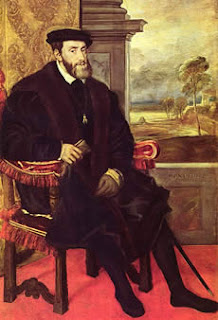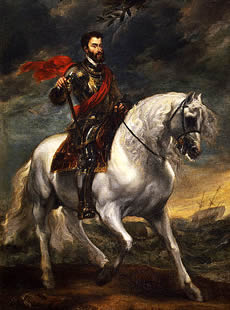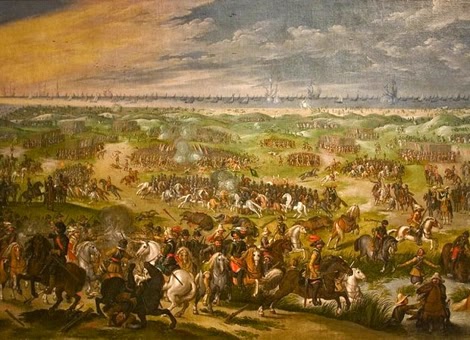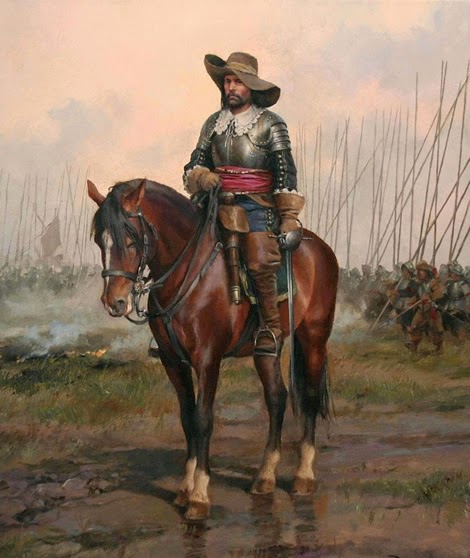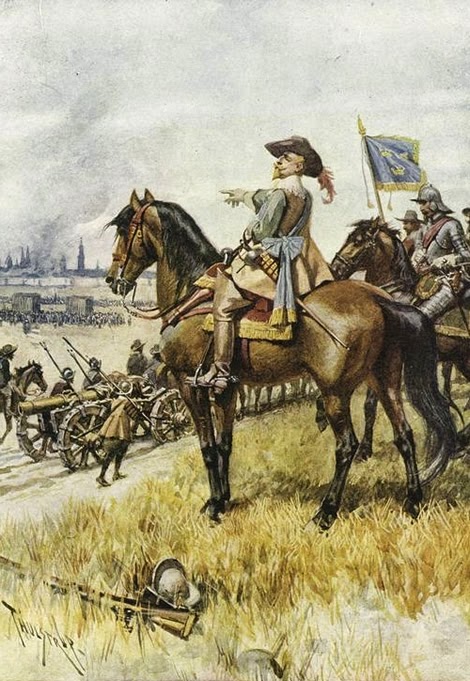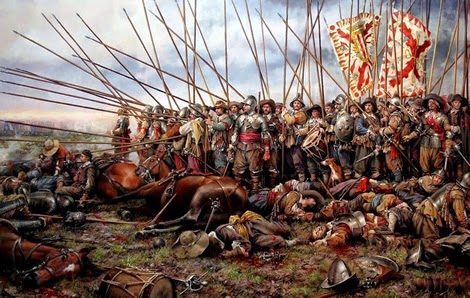 |
| Ottonian Dynasty |
Following the death of Emperor Louis the Pious (814– 840) and the Frankish civil war (840–843), the Carolingian Empire was divided among three sons of Louis. On the eastern ruins of the empire a new kingdom, that of Germany, had emerged, stretching from Holstein in the north down to the Alps in the south, from Lorraine in the west up to the Elbe in the east.
The first
Carolingian kings of Germany struggled for the survival of their fragile kingdom. Their power was challenged not only by foreign invaders, the Slavs, Magyars, and Vikings, but also by rival rulers of France, as well as by some domestic opponents.
In 911 the last Carolingian offspring, Louis the Child (900–911), died and the German nobility elected Conrad, duke of Franconia, as their new king (911–918). Conrad’s son, Henry I (918–936), and later his grandson, Otto I the Great (936–973), succeeded to restore law and order in their kingdom, by bringing different tribes under their control and beating off the invasions.
Ottonian Dynasty After the victory over the Magyars in the Battle of Lechfeld (955) and successful intervention in Italy (951–961), Otto had established himself as undisputed ruler over vast territories in western and central Europe. On February 2, 962, Pope John XII crowned him emperor in Rome. The new
Roman Empire, ruled by the German emperor, had been founded.
Its very title Holy Roman Empire derives from the fact that the act of the imperial coronation, performed by the supreme head of the Christian believers, the pope, was sacral in its character and hence also a sacral character of the imperial dignity and power. The coronation of Otto was by no means an outstanding achievement: The papacy lacked both infl uence and power in those days and was largely subjugated to the goodwill of the German rulers.
Otto II (973–983) succeeded Otto and was married to the Byzantine princess Theophano. The latter introduced a series of Byzantine imperial ceremonies, which were adopted in the Ottonian court. Just as his father before him, Otto II attempted to increase the imperial control over Italy. His invasion of Calabria ended with the defeat of his army by the Arabs in 982. Otto III (983–1002) spent much energy on consolidating the imperial influence in the east.
He created the archbishopric of Gniezno and made Boleslas the Brave, duke of
Poland, patrician. During Henry II’s reign (1002–24) , he had undertaken three military campaigns into Italy, the fi rst of which (1004) intended to punish his unfaithful subject Arduin of Ivrea, who proclaimed himself king of Italy. The second campaign (1013–14) resulted in his imperial coronation by the pope.
Following the third invasion (1020), the imperial power over Italy was firmly established and new German officials were installed for ensuring the imperial control in the region. The warfare with Boleslas I, in which Henry was allied with the pagan Ljutizi, ended in the peace of 1018, by which Henry gave up Bohemia.
Salian Dynasty  |
| Salian Dynasty |
The death of Henry II marked the end of the Ottonian dynasty, which gave way to a new dynasty, the Salians. Its first ruler was Conrad II (1024–39), elected by the German magnates after the death of Henry, despite some opposition that wished to have William III, duke of Aquitaine, crowned as a new king. After his imperial coronation on Easter 1027 his power was reasserted.
He now turned his attention to legal matters, codifying ancient Saxon customs. In 1028 he was victorious in his war against the rebellious Mieszko II, duke of Poland. With peace achieved, Mieszko surrendered all territories conquered by him and his predecessor from the empire. In 1032 Rudolf III, the last king of Burgundy, died, commanding his kingdom to Conrad. Burgundy was annexed to the empire, assuming the name kingdom of Arles.
Conrad and his heirs, Henry III (r. 1039–56) and
Henry IV (r. 1056–1106), attempted to centralize the imperial power, as well as to diminish the influence of regional nobility, lay and religious alike. This led to frequent conflicts and an occasional revolt. The imperial interference with spiritual matters was clearly demonstrated in Henry III’s attempt to reform the papacy.
Between 1046 and 1049 he appointed, one after another, four German bishops as popes, to make German control ubiquitous and to have the emperor as a dominant figure in church matters. Although praised by some churchmen for his efforts to reform the papacy, Henry attracted fierce criticism from among more radical circles in Rome.
During the minority of
Henry IV, the Roman movement was led by an energetic cardinal, Hildebrand, the future Pope Gregory VII (1073–85). In 1059 Hildebrand had decreed that no temporal ruler is authorized to install or depose the pope, who is to be chosen by a college of cardinals.
This may have marked the beginning of the Gregorian Reform, which indulged in a bitter struggle with the Crown known as the Investiture Controversy. The first blow delivered upon the emperor was his humiliation at Canossa (January 1077), with him excommunicated and his empire placed under the interdict.
The first stage of the controversy ended with the
Concordat of Worms (1122) between Henry’s son Henry V (1106–25) and Pope Calixtus II. By the concordat, Henry gave up his authority to invest bishops but kept his right to oversee and take part in the Episcopal elections.
The weakness of the emperor was utilized by the German nobility, which elected Lothar of Supplinburg as their new king Lothar II (1125–37), putting an end to the Salian dynasty. Lothar’s and subsequently Conrad III’s reign (1138–52) is marked by social and dynastic struggle.
Frederick I Barbarossa and Frederick II  |
| Frederick I Barbarossa |
With the election of
Frederick I Barbarossa (1152–90), a new chapter in the history of the German Empire began. Frederick’s primary objective was to restore the imperial control in Italy, over both the rebellious Italian communes and the pope, who had allied himself with King William I of Sicily. The first Italian expedition of 1155 did not produce any significant fruits, while the second campaign (1158) resulted in the reduction of Lombardy into a royal province and rebellion of the Milanese commune.
The fervent Pope Alexander III (1159–81) and the king of Sicily backed the Italian city-states, while Frederick was supported by most of the German magnates and the antipopes. During his fourth Italian march (1166–67) he seized Rome and only an outbreak of malaria, perceived as a divine punishment, forced him to retreat.
In 1174 Frederick led his fifth expedition and despite some agreement reached with the Lombard League, the war resumed, resulting in the imperial defeat in the Battle of Legnano (May 29, 1176). After this, Frederick turned to diplomacy and the confl ict ended with the Peace of Constance (1183). Along with Italian policy, Frederick paid attention to domestic matters.
He expanded the imperial domains by annexing lands of extinct German dynasties and seizing the properties of Henry the Lion, duke of Saxony and Bavaria, in 1180. It was during his reign that the imperial chancery started using the adjective holy to denote the Roman Empire.
Frederick died on his way to the Holy Land leading the Third Crusade. His son Henry VI (1190–97) was married to Constance, the aunt of childless William II, king of Sicily, and upon his ascension he invaded Italy to be crowned in Rome and to claim his Sicilian kingdom. The Sicilian campaign ended in a failure because of the high summer heat and Henry retreated, leaving Sicily ruled by antiking Tancred, William II’s cousin.
After Tancred’s death in 1194 Henry launched another campaign into Sicily, which resulted in the conquest of the
Norman kingdom and Henry’s coronation as king of Sicily on Christmas 1194. Once home, Henry attempted to transform the empire into a hereditary monarchy ruled by the House of the Hohenstaufen.
Upon his death (September 28, 1197), Henry VI left a two-year-old son, the future Frederick II (1212–50). He was raised in Sicily with Pope Innocent III (1198–1216) serving as his guardian. The latter brilliantly exploited the social and political chaos following Henry VI’s death and annexed vast territories in Italy to the papal demesnes.
Philip of Swabia, Henry VI’s brother, was elected as a new king (1198–1208) and his reign is characterized by a continual struggle with his archenemy, Otto of Brunswick. The German and Sicilian nobility, as well as the church with its leader Innocent III, changed sides frequently during the war between the two rivals.
After Philip’s murder, Otto was styled as Otto IV (1208–18). He won Innocent’s support, thanks to his promise to recognize the papal territories in Italy and to allow free episcopal elections, but his failure to carry out these promises led to his excommunication by the pope (November 18, 1210), which ironically coincided with the excommunication of King John of England in 1209.
In the meantime, Frederick II was elected as a new king (September 1211). Frederick had easily won Innocent’s support by confirming Otto’s concessions of 1209. Otto’s declining power was finally crushed after the Battle of Bouvines (July 27, 1214), where the armies of two excommunicated rulers, John of England and Otto of Brunswick, were defeated. Otto died excommunicated in 1218.
The good relationships between pope and emperor were doomed after Innocent’s III death. Frederick failed to keep his promise regarding the separation of Sicily from the German Empire. He instead had his young son Henry crowned
King Henry VII of Germany in 1220 and retreated to his native Sicily. In 1227 Gregory IX excommunicated Frederick for his failure to take the cross.
This resulted in the expedition to the Holy Land known as the Sixth Crusade, where Frederick brilliantly restored Jerusalem to Christian control through his masterful diplomacy. Frederick’s
success and the support of many German princes contributed to the Peace of San Germano, achieved between pope and emperor in 1230.
By this peace Frederick recognized papal territories in Italy and Sicily; however the peace did not last long. In 1237 Frederick renewed imperial hostilities toward the Lombard League, crushing the communal armies in November that year. Gregory excommunicated Frederick in 1239 and called for a church council to depose the emperor, who was seen as the Antichrist.
Frederick invaded Rome in 1241 only to find Gregory dead. Gregory’s successor Innocent IV followed the policy of his predecessor and in 1245 the First Council of Lyon, deposed the emperor. However Frederick’s rule was strong enough to survive this symbolic deposition.
While Frederick was perceived as the Antichrist by the papal circles, his Sicilian companions saw him as a keen promoter of arts and sciences, the founder of the University of Naples (1224); as an open-minded personality, who was equally tolerant to Christians, Jews, and Muslims, Germans, Normans, and Greeks; and as a man of an extraordinary
learning, speaking as many as seven languages and possessing progressive views on economics and government. His extraordinary personality earned him the nickname Stupor Mundi, the Wonder of the World.
Frederick died on December 13, 1250, and his mighty empire collapsed. After the brief reign of his son Conrad IV (1250–54), the German Empire submerged into two decades of political and social chaos, with no recognized king or emperor. During the interregnum period of 1254–73, the Swiss cantons attempted to break free from the imperial control, Charles of Anjou conquered the imperial possessions in Sicily and southern Italy, while France threatened the German territories.
Habsburg Dynasty In autumn of 1273, an assembly of German princes, the Kurfürsten, elected a new king, Rudolf of Habsburg, son of Albrecht IV, count of Habsburg, and Hedwig, daughter of Ulrich of Kyburg. Rudolf is thought to have been a prominent figure well before his crowning, possessing lands and estates in Switzerland and Alsace. Pope Gregory X recognized his election, provided that Rudolf renounce his claims to the imperial title and rule in Rome, Sicily, and the papal lands. Alfonso X of Castile also acknowledged Rudolf’s election.
Challenge to his authority came from within, in the face of Otokar II, king of Bohemia, who refused to surrender his territories in Austria, Styria, Carinthia, and Carniola to Rudolf. After a war that lasted five months, Rudolf seized the aforementioned provinces in November 1276. Otokar retained Bohemia and the peace was consolidated by the betrothal of Otokar’s son Wenceslaus to Rudolf’s daughter. The peace, however, did not remain long, with Otokar allying himself with some German and Polish princes against Rudolf.
The latter, having made an alliance with Ladislas IV of Hungary, met his enemy on the river March on August 26, 1278. The outcome of the battle was the defeat and death of Otokar and subjugation of Moravia. Having overcome the Bohemian challenge, Rudolf turned his attention to consolidating his authority in the Austrian provinces, where he invested his two sons, Albrecht and Rudolf, as dukes of Austria and Styria.
In doing so, Rudolf expected to establish dynastic rule in his kingdom. At the same time, he attempted to restore peace and order in Germany and Switzerland. In 1289 he marched into Thuringia, where he subdued some rebels. His wish of having his son Albert crowned as German king did not come true, with the electing princes refusing to do so. Rudolf died on July 15, 1291.
The assembly elected Adolf, count of Nassau, as the new king. Unlike his predecessor, Adolf lacked power and influence, being from minor nobility. This choice may have been made because the princes, having tasted power in the House of Habsburg, preferred to install a weak ruler.
Crowned as king of the Romans in Aachen on June 2, 1292, and never anointed Holy Roman Emperor by the pope, Adolf did not achieve any significant accomplishment throughout his brief reign (1292–98). His attempts to subdue Thuringia to his rule failed, and his former supporters deposed him, electing Albrecht of Habsburg, Rudolf I’s son, as their king. Adolf refused to recognize Albert’s election and led his army against him, only to be defeated and killed in the Battle of Göllnheim (July 2, 1298).
Albert I’s reign (1298–1308) is characterized by the growing international importance of the House of Habsburg. His attempt to annex territories over the Burgundian frontier led to a conflict with Philip IV the Fair of France (1285–1314).
However, a lack of papal support urged him to abandon his claims in this region. A treaty between the two kings was signed in 1299, by which Albrecht’s son Rudolf was to marry Philip’s daughter Blanche. In 1303, Pope Boniface VIII had finally acknowledged Albert as the German king and Holy Roman Emperor, regarding him as his ally in the conflict with the French Crown.
In 1306 he made his son Rudolf king of Bohemia. He failed to subdue Thuringia, and his army suffered a heavy loss in 1307. Albert was killed on May 1, 1308, on his way to Swabia, where a revolt had broken out. Most contemporary sources depict Albert as a harsh though just ruler as well as a protector of Jewish communities, persecuted in those days.
Luxembourg Dynasty Henry VII of Luxembourg succeeded Albert, was acknowledged by the pope, and was crowned by him as emperor on June 29, 1312. At this time the princes’ assembly was torn between the Habsburg and Luxembourg parties. While in Italy, Henry imposed imperial power on rebellious Florence and interfered in the ongoing war of the Guelphs and Ghebellines, supporters of the pope and emperor, respectively, in Tuscany. He also attempted to subdue his vassal Robert, king of Naples, only to die on August 24, 1313, near Siena.
Upon his death, the Luxembourg party of electors’ assembly elected Louis, or Ludwig, IV Wittelsbach of Bavaria, against the wishes of the Habsburg party, which attempted to install Frederick the Fair Habsburg. Louis’s coronation in 1314 led to a violent confl ict between the latter and the Habsburg heir. Frederick’s army was defeated in 1322 in the Battle of Mühldorf. Having eliminated his rival, Louis set out to consolidate his authority.
He went to Rome in January 1328, and was crowned by an old senator, because of the absence of the pope in the Eternal City. While there he deposed Pope John XXII on the grounds of heresy and appointed a Spiritual Franciscan as antipope Nicholas V, who was deposed as soon as the emperor left Rome in early 1329.
While at home Louis acted as the patron of antipapal intellectuals, such as Marsilius of Padua and William Ockham. In 1338 the princes’ assembly had decreed that the king, chosen by the assembly, did not need papal authorization or coronation. This antipapal policy provoked a harsh reaction of the pope, who was then allied with the French king. In order to withstand the papal-French coalition, Louis made an alliance with Edward III of England. In his domestic policies, he relied much on his power and lands in Bavaria.
In 1340 he united Lower and Upper Bavaria, while two years later he annexed neighboring Tyrol. His increasing authority over smaller territorial rulers led to an inevitable conflict with the latter. In 1346, a year before his death, the electors’ assembly, with the support of Pope Clement VI, chose Charles IV of Luxembourg and Bohemia as an antiking.
Louis IV died on October 11, 1346, and the Crown passed to Charles IV. Although crowned emperor in 1355, Charles, unlike his predecessors, did not strive to revive the idea of the universal Christian Roman Empire, ruled by the German emperor. Instead, he invested his powers and resources in the cultural development of Bohemia, his native land, and Prague, where he resided, in particular.
In 1348 he founded and patronized the Charles University of Prague, which attracted scholars and students with its humanist studies. The emperor corresponded with Petrarch and even invited him to settle in Prague, while the Italian humanist called on Charles to return the imperial throne to Rome. Under Charles’s patronage, some of the finest monuments of Old Prague were built.
While most of the emperor’s attention was concentrated on Bohemia, other parts of the empire, especially Germany, suffered from a social crisis following the epidemics of the Black Death (1348–51). Charles issued his famous
Golden Bull of 1356, which attempted to define the procedure of imperial election and the annual diet held by the electoral princes. Raised and educated at the French royal court, Charles was related to John II (1350–64) and Charles V (1364–80) of France and supported them in the French struggle against England.
Charles IV died on November 29, 1378, and the titles of the king of Bohemia and king of the Romans passed to his son, Wenceslaus (known as Wenceslaus, or Vaclav IV the Drunkard). Just as his father, Wenceslaus devoted much of his attention to his native Bohemia. His Bohemo-central policy provoked a rebellion of the German princes, who deposed him as king in August 1400, electing the German Rupert, count of Palatine.
Wenceslaus did not give up the title of the king of the Germans and continued reigning in Bohemia until his death in 1419, without acknowledging his deposition and the crowning of Rupert. This also marks the beginning of animosity between Bohemia and Germany, on political, national, and cultural levels. It was under Wenceslaus that the Hussite movement started by John Huss started gaining ground in Bohemia.
After Rupert’s death in 1410 the princes’ assembly elected Sigismund of Luxembourg, margrave of Brandenburg and king of Hungary. Soon after his election, Wenceslaus of Bohemia, his half brother, renounced his claim to the title of king of the Romans and Sigismund was universally recognized as such. During his reign, the history of Hungary became interwoven with that of the Holy Roman Empire.
The two main objectives of his early reign were to put an end to the Papal Schism (1378–1417) and to crush the Hussite movement in Bohemia. Both problems were solved at the Council of Constance (1414–17), where Sigismund was a key figure. The two leaders of the Hussite movement, John Huss and Jerome of Prague, were burned at the stake on July 6, 1415, and May 30, 1416, respectively.
The Papal Schism was ended by the deposition of three rival popes and election of a new one, Martin V. The martyrdom of Huss and Jerome resulted in street riots in Prague, which swiftly transformed into a civil war. In the meantime Wenceslaus died and Sigismund inherited the title of king of Bohemia.
In 1420 he attempted to restore peace and order, only to be rejected by the Bohemian nobility and repulsed by the Hussite army, led by some remaning commanders. The Hussite wars continued until 1436, devastating various eastern regions of the empire. Only a later schism within the movement itself allowed Sigismund to take over. In 1437 a short time before his death, the local nobility accepted him as the king of Bohemia.
Albrecht II Habsburg of Austria succeeded Sigismund, ruling briefly for two years (1437–1439). He also inherited the reigns of Hungary and Bohemia. The Bohemian nobility rejected Albrecht as their king, allied itself with the Poles, and rebelled against him. As king of Hungary, he spent his energy defending the realm against the Ottoman Empire.
Frederick III and Maximilian After Albert’s death, Frederick III was elected as king of the Germans in 1440. To consolidate his power, he signed the Vienna Concordat with the papacy in 1446, which codified the relationships between the emperor and the pope. Frederick was crowned emperor in 1452, the last imperial crowning in Rome. While unsuccessful in battle, Frederick achieved brilliant results through diplomacy.
In 1452 Frederick married Eleanor of Portugal, receiving a considerable dowry. In 1475 he forced Charles the Bald, duke of Burgundy, to marry his daughter to Frederick’s son, Maximilian. Despite this, his rivals frequently challenged Frederick’s power.
The first challenge came from Albrecht VI, his brother. Between 1458 and 1463 the two fought each other over the control of Austria. The struggle with his nephew, Ladislaus Posthumus, over Hungary and Bohemia, resulted in the capture and imprisonment of the latter. His main rival, however, was a powerful Hungarian king, Matthias Corvinus (1458–90), who seized some of Frederick’s possessions in Austria, Moravia, and Silesia and then took Vienna in 1485.
The collapse of Frederick’s power was prevented only by Corvinus’s death in 1490. The last 10 years of his life, Frederick ruled jointly with his son, Maximilian, who had been crowned the king of the Romans in 1486 and inherited his father’s imperial title after the latter’s death in 1493.
Maximilian held vast territorial possessions well before his ascension to the throne. In 1477 after the death of Charles the Bald of Burgundy, he had inherited the Free County of Burgundy, along with the Netherlands. In 1490 he acquired Tyrol and some parts of Austria from his half-uncle Sigismund.
In 1494 the emperor entered into a conflict with France over the intervention in Italy, which led to the Italian Wars of 1494–1559. He did not live to see his armies beat the French enemy. In 1499 the empire suffered heavy losses in the Battle of Dornach at the hands of the Swiss Confederation, which forced the emperor to acknowledge the independence of the Swiss cantons.
While at home Maximilian tried to reform the imperial constitution. In 1495 the Reichstag of Worms had issued four documents, known as the Reichsreform, which created and legalized two legal establishments: the Reichskreise (Imperial Circle), whose main function was to collect taxes and organize a common defense, and the Reichskammergericht (Imperial Chamber Court), the highest judicial institution of the empire.
Under Maximilian, and perhaps even under his father, Frederick III, the Holy Roman Empire began to rise to be the premier power in Europe. With the election of Maximilian’s grandson, Charles V of Spain, the empire became the largest territorial unit in Europe, encompassing central Europe, Germany, the Low Countries, parts of Burgundy, and Spain with its vast American colonies.
